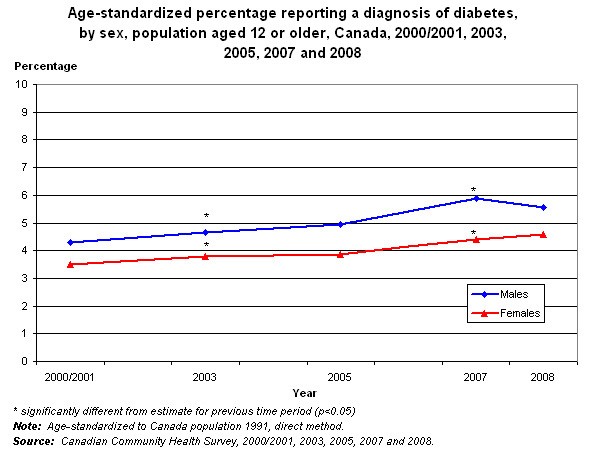Publications
Healthy people, healthy places
+Demographic change
+Health status
+Health behaviours
+Environment
Diabetes
Archived Content
Information identified as archived is provided for reference, research or recordkeeping purposes. It is not subject to the Government of Canada Web Standards and has not been altered or updated since it was archived. Please "contact us" to request a format other than those available.
The presence of diabetes is based on the population aged 12 or older who reported that a health professional diagnosed them as having diabetes. This includes females 15 or older who reported that they have been diagnosed with gestational diabetes. The definition does not distinguish between type 1 and type 2 diabetes
Importance of indicator
Diabetes is an important indicator of population health because of its increasing prevalence, association with lifestyle risk factors, and far-reaching consequences. Common complications include heart disease and stroke, vision problems or blindness, kidney failure, and nerve damage1.
Background
The prevalence of type 2 diabetes is increasing worldwide2. Formerly considered a disease of adults and the elderly, it is now appearing in children3,4. The burdens imposed by diabetes include shortened life expectancy and fewer years lived in good health, as well as health care costs for those afflicted.
The aging population is the most important demographic change affecting diabetes prevalence worldwide. Even if incidence rates were to remain stable, because of the growing number of seniors, the overall prevalence of diabetes would increase2,5.
Being overweight or obese is an important risk factor for diabetes6. Rising percentages of Canadians in these categories7 could increase the prevalence of diabetes.
Physical activity reduces the risk of developing diabetes and inhibits the progression of the disease by increasing sensitivity to insulin. Even when body mass index (BMI) and other factors were taken into account, diabetes incidence was higher among inactive people5.
Family history (parent or sibling with diabetes) was associated with an increased risk of developing diabetes5. While this may indicate a genetic predisposition, shared behaviours and increased awareness that leads to testing might also be factors associated with the family history.
Some association between socio-economic status and diabetes was evident in a Canadian study, which found that those with less than secondary graduation were more likely to report a diagnosis of diabetes. However, when sex, family history and lifestyle factors were controlled, education was no longer associated with developing diabetes5.
Highlights and graphs
Time trend

- As in other countries2 self-reported diabetes increased among both males and females in Canada between 2000/2001 and 2008, even when the aging population was taken into account.
- A combination of demographic, lifestyle and clinical factors may account for this increase5:
- a decline in diabetes mortality;
- increased prevalence of overweight and obesity, an important risk factor;
- broader diagnostic criteria that affect the number of cases identified;
- and growing awareness among physicians and the public that could lead to increased detection.
- Males were consistently more likely than females to report a diagnosis of diabetes.
Note: Age–standardized, direct method to 1991 Canada population.
Age group and sex

- In 2008, 6.3% of males (900,000) and 5.4% of females (800,000) aged 12 or older reported a diagnosis of diabetes. The actual number of people with diabetes is likely to be even higher8 because many people with diabetes may not be aware of it.
- Diabetes becomes more prevalent with advancing age—1 in 6 senior males and 1 in 7 senior females reported a diagnosis of diabetes, compared with fewer than 1 in 200 people aged 12 to 24.
- Overall, males were more likely than females to be diagnosed with diabetes, particularly at ages 55 or older. Females in the 25 to 34 year old age group were more likely than males to report such a diagnosis.
Province

- The age-standardized prevalence of diabetes varied somewhat across Canada. Residents of Newfoundland and Labrador and New Brunswick were more likely than Canadians overall to report a diagnosis of diabetes.
- Residents of British Columbia and Yukon were less likely to report such a diagnosis.
- These percentages were significantly different from the national percentage, even when accounting for the differing age structures in these provinces and territories.
Note: Age–standardized, direct method to 1991 Canada population.
References
1. Public Health Agency of Canada. Complications of diabetes. 2009
2. Wild S, Roglic G, Green A, et al. Global prevalence of diabetes: estimates for the year 2000 and projections for the year 2030. Diabetes Care 2004;27(5):1047-1053.
3. American Diabetes Association. Type 2 diabetes in children and adolescents. Diabetes Care 2000;23(3)381-389.
4. Harris SB, Perkins BA, Walen-Brough E. Non-insulin-dependent diabetes mellitus among First Nations children. Canadian Family Physican 1996;42:869-876.
5. Millar WJ, Young TK. Tracking diabetes: Prevalence, incidence and risk factors. Health Reports (Statistics Canada, Catalogue 82-003) 2003;14(3):35-47.
6. Haslam DW, James WPT. Obesity. Lancet 2005;366:1197-1209.
7. Tjepkema M. Adult obesity. Health Reports (Statistics Canada, Catalogue 82-003) 2006;17(3)9-21.
8. Young TK and Mustard CA. Undiagnosed diabetes: does it matter? CMAJ 2001; 164(1): 24-28.
Other studies
James R, Young TK, Mustard CA, Blanchard J. The health of Canadians with diabetes. Health Reports (Statistics Canada, Catalogue 82-003) 1997; 9(3): 47-52.
Ng E, Dasgupta K, Johnson JA. An algorithm to differentiate diabetic respondents in the Canadian Community Health Survey. Health Reports (Statistics Canada, Catalogue 82-003) 2008; 19(1): 71-9.
Sanmartin C, Gilmore J. Diabetes – prevalence and care practices. Health Reports (Statistics Canada, Catalogue 82-003) 2008; 19(3): 59-63.
- Date modified:
